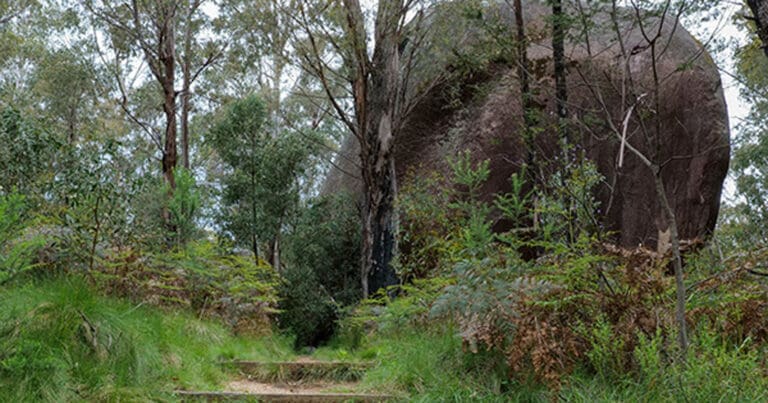Hike at a Glance
Max elevation: 773m
Min elevation: 764m
Total Ascent: 21m
Hike overview
The Black Flats Dam walk is a delightful 800-metre return trail, perfect for visitors seeking a short and scenic introduction to Tidbinbilla Nature Reserve, ACT. This easy grade 2 walk takes roughly 30 minutes to complete and requires no prior bushwalking experience.
The well-maintained track leads you across the Tidbinbilla River and through a small section of forest, culminating at the tranquil Black Flats Dam. Take a moment of quiet reflection by the water's edge – you might be rewarded with a glimpse of shy platypus or turtles basking in the sun.
This walk serves as an entry point to the Sanctuary via the Black Flats Link Trail, offering the opportunity to explore the reserve's diverse wildlife further. The starting point is conveniently located at the Black Flats car park.
Gallery
Got some great shots from this hike? Upload your photos here to inspire others and show off the beauty of the trail!
Click to view form >>
Submitting your photos doesn’t mean you lose ownership. You can be credited for your contributions, and you can request removal at any time.
Content use
Please don’t copy GPX files or content from this site to AllTrails or other platforms. Each trail has been personally mapped, documented, and refined to support Australia’s bushwalking and hiking community. While some details come from land managers, every listing reflects significant personal effort. This is a free, community-driven initiative—your respect helps keep it that way.
Walk map and GPX file
Max elevation: 773 m
Min elevation: 764 m
Total climbing: 21 m
Total descent: -21 m
Getting there
Getting to the trailhead: Tidbinbilla Nature Reserve.
Tidbinbilla Nature Reserve is located on Tidbinbilla Reserve Road, Paddys River, about 40km from the centre of Canberra. Nestled within the Tidbinbilla Valley and surrounded by Namadgi National Park, both the drive and destination are experiences in themselves. Tidbinbilla is an easy 45-minute drive south-west from the centre of Canberra. Access is off Paddys River Road, via Cotter Road (from North Canberra) or via Drakeford Drive, Woodcock Ave and Point Hut Crossing (from South Canberra).
Closest towns to this walk: Banks, Calwell, Conder, Cooleman, Cooleman Ridge, Coree, Cotter River, Dunlop, Durras, Gordon, Hall, Isaacs, Kambah, Mawson, Narrabundah, Paddys River, Tharwa, Tuggeranong, Uriarra Village, Wanniassa, Weston Creek, Woden
About the region
Tidbinbilla Nature Reserve, a 54.5-square-kilometre sanctuary located just 40 minutes' drive from Canberra, the capital of New South Wales, offers a captivating glimpse of Australian nature. The reserve encompasses diverse landscapes, from rugged peaks and rolling grasslands to ancient rock shelters and cascading creeks. Diverse habitats like wetlands, forests and woodlands provide a haven for a rich variety of wildlife. Kangaroos, wallabies, koalas, and even the elusive platypus can all be spotted here.
Tidbinbilla caters to all interests. Explore the network of 24 marked walks, ranging from gentle strolls to challenging hikes that lead to the summit of the Tidbinbilla Range. Enjoy a picnic in one of the designated areas with free barbecue facilities, or let the kids loose at the Nature Discovery Playground. Learn about the rich cultural heritage of the Ngunnawal people, the Traditional Custodians of the land. Visit significant sites like Hanging Rock, Birrigai Rock Shelter, Gibraltar Peak and the Wandarawari Track. Ascend Gibraltar Peak, Johns Peak or Camels Hump for breathtaking panoramic views.
The Tidbinbilla Visitor Centre provides valuable information, sells snacks, gifts and barista-made coffee. Guided activities are available on weekends and during school holidays, with options for custom group bookings. Tidbinbilla Nature Reserve is a significant conservation area, playing a vital role in protecting Australian ecosystems since 1936.
Similar walks nearby
Looking for more walks in or near Tidbinbilla Nature Reserve? Try these trails with a similar difficulty grade.
Track grade
Grade 2 (Easy) - A Gentle Introduction to Inclines: Grade 2 on the AWTGS represents easy walking tracks that offer a slightly more challenging experience compared to Grade 1. Similar to Grade 1, no prior bushwalking experience is required. The track surface is typically hardened or compacted and may have gentle hill sections or occasional steps. The total distance of a Grade 2 walk is typically no greater than 10 kilometers. These walks are still suitable for families with a bit more experience or those seeking a gentle introduction to some inclines.
Explore safe
Plan ahead and hike safely! Carry enough water, pack layers for changing conditions, and bring safety gear like a torch, PLB, and reliable communication device. Check official sources for trail updates, closures, and access requirements, and review local weather and bushfire advice. Most importantly, share your plans with someone before you go. Being prepared makes for a safer and more enjoyable hike! Stay Safe, Explore More, and Always #ExploreSafe.
Packing checklists
What you carry in your pack depends on factors like weather, terrain, and your adventure type. Not sure what to bring? My free planning, food, and packing checklists are a great starting point, covering day hikes, overnight trips, and multi-day adventures. Use them to customise your kit and always prioritise safety.
Let someone know
Before heading out, take a moment to fill out your trip intentions form. It’s a quick way to share your hike details with family or friends. If something goes wrong, they can notify emergency services, ensuring a faster response and peace of mind. Stay safe and enjoy your adventure
Suggest an edit
Spotted a change on this trail? Maybe there are new features, the route has shifted, or the trail is permanently closed. Whatever the update, I’d love your input. Your feedback helps fellow hikers stay informed and ensures that our trail info stays fresh and reliable.
Acknowledgement of Country
Trail Hiking Australia acknowledges the Traditional Owners of the lands on which we hike and pay respects to their Elders, past and present, and we acknowledge the First Nations people of other communities who may be here today.






